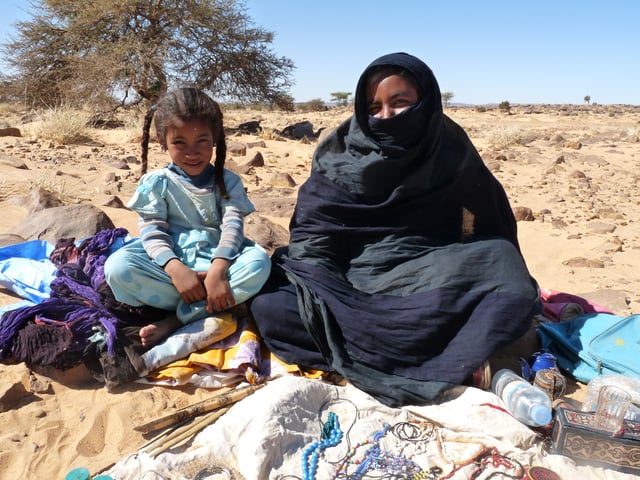Mauritania
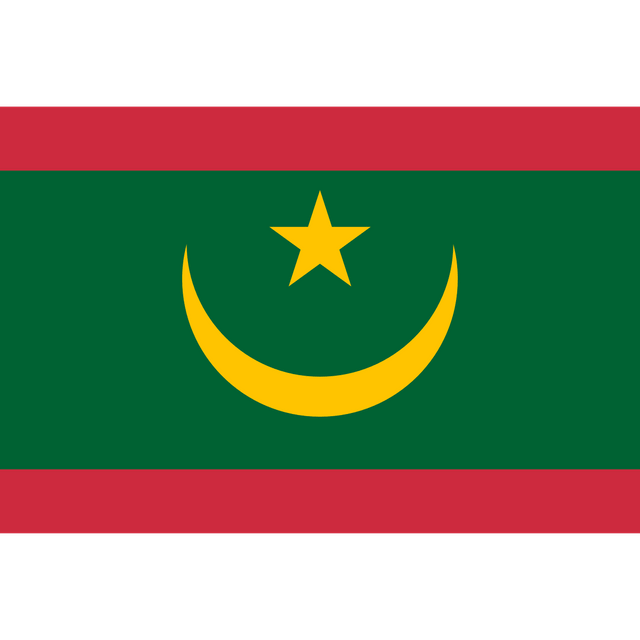
Mauritania

Islamic Republic of Mauritania الجمهورية الإسلامية الموريتانية(Arabic) République islamique de Mauritanie(French) | |
|---|---|
Motto:شرف إخاء عدل(Arabic) "Honor, Fraternity, Justice" | |
Anthem:نشيد وطني موريتاني (English:"Country of the Proud, Guiding Noblemen") | |
 Location of Mauritania (dark blue) in Africa | |
 | |
| Capital and largest city | Nouakchott 18°09′N 15°58′W [91] |
| Official languages | Arabic |
| Recognised national languages |
|
| Other languages | French[1] |
| Ethnic groups |
|
| Religion | Islam |
| Demonym(s) | Mauritanian |
| Government | Unitary semi-presidential Islamic republic |
• President | Mohamed Ould Ghazouani |
• Prime Minister | Ismail Ould Bedde Ould Cheikh Sidiya |
• President of the National Assembly | Cheikh Ahmed Baye[3] |
| Legislature | National Assembly |
| Independence | |
• from France | 28 November 1960 |
• Current Constitution of Mauritania | 12 July 1991 |
| Area | |
• Total | 1,030,000 km2(400,000 sq mi)[4] (28th) |
• Water (%) | 0.03 |
| Population | |
• 2016 estimate | 4,301,018[5] |
• 2013 census | 3,537,368[4] |
• Density | 3.4/km2(8.8/sq mi) |
| GDP(PPP) | 2018 estimate |
• Total | $18.117 billion[6] (134th) |
• Per capita | $4,563[6] (140th) |
| GDP(nominal) | 2018 estimate |
• Total | $5.200 billion[6] (154th) |
• Per capita | $1,309[6] (149th) |
| Gini(2008) | 40.5[7] medium |
| HDI(2017) | low · 159th |
| Currency | Ouguiya (MRU) |
| Time zone | UTC+0(GMT) |
| Driving side | right |
| Calling code | +222 |
| ISO 3166 code | MR |
| Internet TLD | .mr |
| |
Mauritania (/ˌmɒrɪˈteɪniə, ˌmɔːrɪ-/ (listen);[9] Arabic: موريتانيا, Mūrītānyā, French: Mauritanie), officially the Islamic Republic of Mauritania, is a country in Northwest Africa. It is the eleventh largest sovereign state in Africa and is bordered by the Atlantic Ocean to the west, Western Sahara to the north and northwest, Algeria to the northeast, Mali to the east and southeast, and Senegal to the southwest.
The country derives its name from the ancient Berber kingdom of Mauretania, which existed from the 3rd century BCE into the 7th century CE in the far north of modern-day Morocco and Algeria. Approximately 90% of Mauritania's land is within the Sahara; consequently, the population is concentrated in the south, where precipitation is slightly higher. The capital and largest city is Nouakchott, located on the Atlantic coast, which is home to around one-third of the country's 4.3 million people. The government was overthrown on 6 August 2008, in a military coup d'état led by General Mohamed Ould Abdel Aziz. On 16 April 2009, Aziz resigned from the military to run for president in the 19 July elections, which he won.[10]
Islamic Republic of Mauritania الجمهورية الإسلامية الموريتانية(Arabic) République islamique de Mauritanie(French) | |
|---|---|
Motto:شرف إخاء عدل(Arabic) "Honor, Fraternity, Justice" | |
Anthem:نشيد وطني موريتاني (English:"Country of the Proud, Guiding Noblemen") | |
 Location of Mauritania (dark blue) in Africa | |
 | |
| Capital and largest city | Nouakchott 18°09′N 15°58′W [91] |
| Official languages | Arabic |
| Recognised national languages |
|
| Other languages | French[1] |
| Ethnic groups |
|
| Religion | Islam |
| Demonym(s) | Mauritanian |
| Government | Unitary semi-presidential Islamic republic |
• President | Mohamed Ould Ghazouani |
• Prime Minister | Ismail Ould Bedde Ould Cheikh Sidiya |
• President of the National Assembly | Cheikh Ahmed Baye[3] |
| Legislature | National Assembly |
| Independence | |
• from France | 28 November 1960 |
• Current Constitution of Mauritania | 12 July 1991 |
| Area | |
• Total | 1,030,000 km2(400,000 sq mi)[4] (28th) |
• Water (%) | 0.03 |
| Population | |
• 2016 estimate | 4,301,018[5] |
• 2013 census | 3,537,368[4] |
• Density | 3.4/km2(8.8/sq mi) |
| GDP(PPP) | 2018 estimate |
• Total | $18.117 billion[6] (134th) |
• Per capita | $4,563[6] (140th) |
| GDP(nominal) | 2018 estimate |
• Total | $5.200 billion[6] (154th) |
• Per capita | $1,309[6] (149th) |
| Gini(2008) | 40.5[7] medium |
| HDI(2017) | low · 159th |
| Currency | Ouguiya (MRU) |
| Time zone | UTC+0(GMT) |
| Driving side | right |
| Calling code | +222 |
| ISO 3166 code | MR |
| Internet TLD | .mr |
| |
Names and pronunciation
Mauritania (/ˌmɒrɪˈteɪniə, ˌmɔːrɪ-/ (listen);[9] (Arabic: موريتانيا, Mūrītānyā, French: Mauritanie) is officially known as the Islamic Republic of Mauritania (Arabic: الجمهورية الإسلامية الموريتانية). In other languages, it is known variously as Agawej or Cengiṭ (Berber), Gànnaar (Wolof), Murutaane (Soninke), and Moritani (Pulaar).[11][12][13]
History and politics
Ancient history
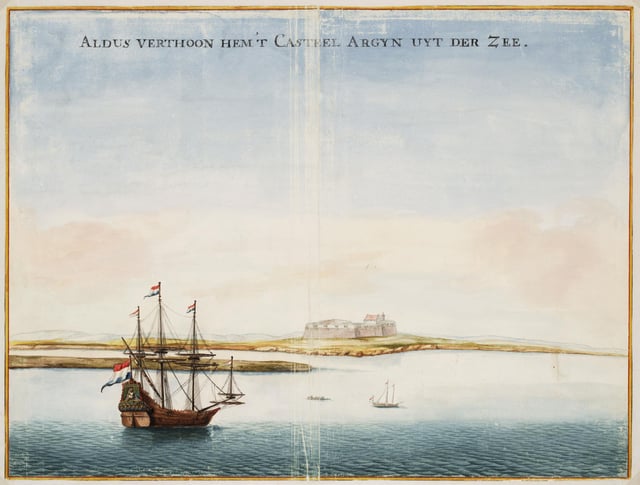
The Dutch trading post of Arguin in 1665
The ancient tribes of Mauritania were Berber people. The Bafours were primarily agricultural, and among the first Saharan people to abandon their historically nomadic lifestyle. With the gradual desiccation of the Sahara, they headed south. Many of the Berber tribes claimed Yemeni (and sometimes other Arab) origins. There is little evidence to support such claims, but a 2000 DNA study of Yemeni people suggested there might be some ancient connection between the peoples.[14]
Other peoples also migrated south past the Sahara to West Africa. In 1076, Moorish Islamic warrior monks (Almoravid or Al Murabitun) attacked and conquered the large area of the ancient Ghana Empire.
The Char Bouba war (1644–74) was the unsuccessful final effort of the peoples to repel the Yemeni Maqil Arab invaders. The invaders were led by the Beni Hassan tribe. The descendants of the Beni Hassan warriors became the upper stratum of Moorish society. Hassaniya, a bedouin Arabic dialect that derives its name from the Beni Hassan, became the dominant language among the largely nomadic population.[15]
Berbers retained a niche influence by producing the majority of the region's marabouts: those who preserve and teach Islamic tradition.[15]
Colonial history and present day
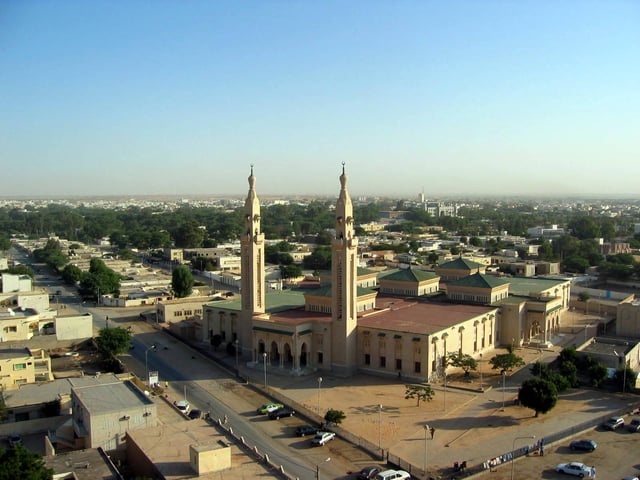
Nouakchott is the capital and the largest city of Mauritania. It is one of the largest cities in the Sahara.
Imperial France After war laid Claim to the territories of present-day Mauritania from the Senegal River area and northwards, starting in the late 19th century. In 1901, Xavier Coppolani took charge of the imperial mission. Through a combination of strategic alliances with Zawaya tribes, and military pressure on the Hassane warrior nomads, he managed to extend French rule over the Mauritanian emirates. Trarza, Brakna and Tagant were occupied by the French armies in 1903–04, but the northern emirate of Adrar held out longer, aided by the anti-colonial rebellion (or jihad) of shaykh Maa al-Aynayn, as well by insurgents from Tagant and the other regions. Adrar was finally defeated militarily in 1912, and incorporated into the territory of Mauritania, which had been drawn up and planned in 1904. Mauritania was part of French West Africa from 1920, as a protectorate and, then, a colony.[16]
French rule brought legal prohibitions against slavery and an end to inter-clan warfare. During the colonial period, 90% of the population remained nomadic. Many sedentary peoples, whose ancestors had been expelled centuries earlier, began to trickle back into Mauritania. The previous capital of the country under the French rule, Saint-Louis, was located in Senegal, so when the country gained independence in 1960, Nouakchott, at the time little more than a fortified village ("ksar"), was chosen as the site of the new capital of Mauritania.[17]
After gaining independence, larger numbers of indigenous Sub-Saharan African peoples (Haalpulaar, Soninke, and Wolof) entered Mauritania, moving into the area north of the Senegal River. Educated in French language and customs, many of these recent arrivals became clerks, soldiers, and administrators in the new state. This occurred as the French militarily suppressed the most intransigent Hassane tribes in the north. This changed the former balance of power, and new conflicts arose between the southern populations and Moors. Between these groups stood African origins, who is part of the Arab society, integrated into a low-caste social position.[18]
Modern-day slavery still exists in different forms in Mauritania.[19] According to some estimates, thousands of Mauritanians are still enslaved.[20][21][22] A 2012 CNN report, "Slavery's Last Stronghold," by John D. Sutter, describes and documents the ongoing slave-owning cultures.[23] This social discrimination is applied chiefly against the "black Moors" (Haratin) in the northern part of the country, where tribal elites among "white Moors" (Bidh'an, Hassaniya-speaking Arabs and Arabized Berbers) hold sway.[24] Slavery practices exist also within the sub-Saharan African ethnic groups of the south.
The great Sahel droughts of the early 1970s caused massive devastation in Mauritania, exacerbating problems of poverty and conflict. The Arabized dominant elites reacted to changing circumstances, and to Arab nationalist calls from abroad, by increasing pressure to Arabize many aspects of Mauritanian life, such as law and the education system. This was also a reaction to the consequences of the French domination under the colonial rule. Various models for maintaining the country's cultural diversity have been suggested, but none was successfully implemented.
This ethnic discord was evident during inter-communal violence that broke out in April 1989 (the "Mauritania–Senegal Border War"), but has since subsided. Mauritania expelled some 70,000 sub-Saharan African Mauritanians in the late 1980s.[25] Ethnic tensions and the sensitive issue of slavery – past and, in some areas, present – are still powerful themes in the country's political debate. A significant number from all groups seek a more diverse, pluralistic society.
Conflict with Western Sahara
The International Court of Justice has concluded that in spite of some evidence of both Morocco's and Mauritania's legal ties prior to Spanish colonization, neither set of ties was sufficient to affect the application of the UN General Assembly Declaration on the Granting of Independence to Colonial Countries and Peoples to Western Sahara.[26]
Mauritania, along with Morocco, annexed the territory of Western Sahara in 1976, with Mauritania taking the lower one-third at the request of Spain, a former imperial power. After several military losses from the Polisario – heavily armed and supported by Algeria, the regional power and rival to Morocco – Mauritania withdrew in 1979. Its claims were taken over by Morocco.
Due to economic weakness, Mauritania has been a negligible player in the territorial dispute, with its official position being that it wishes for an expedient solution that is mutually agreeable to all parties. While most of Western Sahara has been occupied by Morocco, the UN still considers the Western Sahara a territory that needs to express its wishes with respect to statehood. A referendum is still supposed to be held sometime in the future, under UN auspices, to determine whether or not the indigenous Sahrawis wish to be independent, as the Sahrawi Arab Democratic Republic, or to be part of Morocco.
Ould Daddah era (1960–1978)
Mauritania became an independent nation in November 1960.[27] In 1964 President Moktar Ould Daddah, originally installed by the French, formalized Mauritania as a one-party state with a new constitution, setting up an authoritarian presidential regime. Daddah's own Parti du Peuple Mauritanien (PPM) became the ruling organization in a one-party system. The President justified this on the grounds that Mauritania was not ready for western-style multi-party democracy. Under this one-party constitution, Daddah was reelected in uncontested elections in 1976 and 1978.
He was ousted in a bloodless coup on 10 July 1978. He had brought the country to near-collapse through a disastrous war to annex the southern part of Western Sahara, framed as an attempt to create a "Greater Mauritania".
CMRN and CMSN military governments (1978–1984)

Chinguetti was a center of Islamic scholarship in West Africa.
Col. Mustafa Ould Salek's CMRN junta proved incapable of either establishing a strong base of power or extracting the country from its destabilizing conflict with the Sahrawi resistance movement, the Polisario Front. It quickly fell, to be replaced by another military government, the CMSN.
The energetic Colonel Mohamed Khouna Ould Haidallah soon emerged as its strongman. By giving up all claims to Western Sahara, he found peace with the Polisario and improved relations with its main backer, Algeria. But relations with Morocco, the other party to the conflict, and its European ally France deteriorated. Instability continued, and Haidallah's ambitious reform attempts foundered. His regime was plagued by attempted coups and intrigue within the military establishment. It became increasingly contested due to his harsh and uncompromising measures against opponents; many dissidents were jailed, and some executed. In 1981 slavery was formally abolished by law, making Mauritania the last country in the world to do so.
Ould Taya's rule (1984–2005)
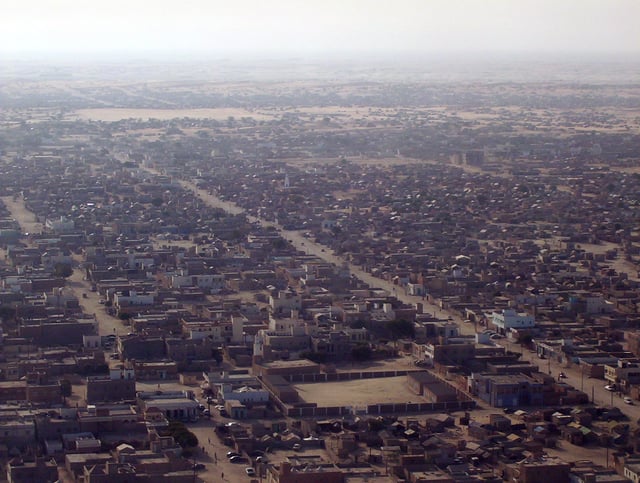
Aerial view of Nouakchott. The population of Nouakchott has increased from 20,000 in 1969 to almost 1 million in 2013.
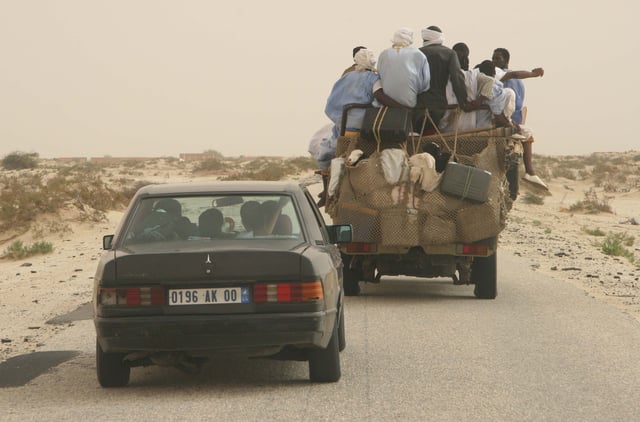
Road from Nouakchott to the Mauritanian–Senegalese border
In December 1984, Haidallah was deposed by Colonel Maaouya Ould Sid'Ahmed Taya, who, while retaining tight military control, relaxed the political climate. Ould Taya moderated Mauritania's previous pro-Algerian stance, and re-established ties with Morocco during the late 1980s. He deepened these ties during the late 1990s and early 2000s as part of Mauritania's drive to attract support from Western states and Western-aligned Arab states. Mauritania has not rescinded its recognition of Polisario's Western Saharan exile government, and remains on good terms with Algeria. Its position on the Western Sahara conflict is, since the 1980s, one of strict neutrality.
Ordinance 83.127, enacted 5 June 1983, started the process of nationalization of all land not clearly the property of a documented owner, thus abolishing the traditional system of land tenure. Potential nationalization was based on the concept of "dead land",[28] i.e., property which has not been developed or on which obvious development cannot be seen. A practical effect was government seizure of traditional communal grazing lands.[29] []
Political parties, illegal during the military period, were legalized again in 1991. By April 1992, as civilian rule returned, 16 major political parties had been recognized; 12 major political parties were active in 2004. The Parti Républicain Démocratique et Social (PRDS), formerly led by President Maaouya Ould Sid'Ahmed Taya, dominated Mauritanian politics after the country's first multi-party elections in April 1992, following the approval by referendum of the current constitution in July 1991. President Taya won elections in 1992 and 1997. Most opposition parties boycotted the first legislative election in 1992. For nearly a decade the parliament was dominated by the PRDS. The opposition participated in municipal elections in January–February 1994, and in subsequent Senate elections – most recently in April 2004 – and gained representation at the local level, as well as three seats in the Senate.
This period was marked by extensive ethnic violence and human rights abuses. Between 1990 and 1991, a campaign of particularly extreme violence took place against a background of Arabization, interference with blacks' association rights, expropriation and expatriation.[30]
In October 1987, the government allegedly uncovered a tentative coup d'état by a group of black army officers, backed, according to the authorities, by Senegal.[31] Fifty-one officers were arrested and subjected to interrogation and torture.[32] Heightened ethnic tensions were the catalyst for the Mauritania–Senegal Border War, which started as a result of a conflict in Diawara between Moorish Mauritanian herders and Senegalese farmers over grazing rights.[33] On 9 April 1989, Mauritanian guards killed two Senegalese.[34]
Following the incident, several riots erupted in Bakel, Dakar and other towns in Senegal, directed against the mainly Arabized Mauritanians who dominated the local retail business. The rioting, adding to already existing tensions, led to a campaign of terror against black Mauritanians,[35] who are often seen as 'Senegalese' by Bidha'an, regardless of their nationality. As low scale conflict with Senegal continued into 1990/91, the Mauritanian government engaged in or encouraged acts of violence and seizures of property directed against the Halpularen ethnic group. The tension culminated in an international airlift agreed to by Senegal and Mauritania under international pressure to prevent further violence. The Mauritanian Government expelled tens of thousands of black Mauritanians. Most of these so-called 'Senegalese' had no ties to Senegal, and many have been repatriated from Senegal and Mali after 2007.[32] The exact number of expulsions is not known but the United Nations High Commissioner for Refugees (UNHCR) estimates that, as of June 1991, 52,995 Mauritanian refugees were living in Senegal and at least 13,000 in Mali.[29] []
From November 1990 to February 1991, between 200 and 600 (depending on the sources) Fula and Soninke soldiers and/or political prisoners were executed or tortured to death by Mauritanian government forces. They were among 3,000 to 5,000 blacks – predominantly soldiers and civil servants – arrested between October 1990 and mid-January 1991.[36][37] Some Mauritanian exiles believe that the number was as high as 5,000 on the basis of alleged involvement in an attempt to overthrow the government.[38]
The government initiated a military investigation but never released the results.[38] In order to guarantee immunity for those responsible and to block any attempts at accountability for past abuses, the Parliament declared an amnesty[39] in June 1993 covering all crimes committed by the armed forces, security forces as well as civilians, between April 1989 and April 1992. The government offered compensation to families of victims, which a few accepted in lieu of settlement.[38] Despite this amnesty, some Mauritanians have denounced the involvement of the government in the arrests and killings.[29] []
In the late 1980s, Ould Taya had established close co-operation with Iraq, and pursued a strongly Arab nationalist line. Mauritania grew increasingly isolated internationally, and tensions with Western countries grew dramatically after it took a pro-Iraqi position during the 1991 Gulf War. During the mid-to late 1990s, Mauritania shifted its foreign policy to one of increased co-operation with the US and Europe. It was rewarded with diplomatic normalization and aid projects. On 28 October 1999, Mauritania joined Egypt, Palestine, and Jordan as the only members of the Arab League to officially recognize Israel. Ould Taya also started co-operating with the United States in anti-terrorism activities, a policy which was criticized by some human rights organizations.[40][41] (See also Foreign relations of Mauritania.)
A group of current and former Army officers launched a violent and unsuccessful coup attempt on 8 June 2003. The leaders of the attempted coup escaped from the country, but some of them were caught, later on. Mauritania's presidential election, its third since adopting the democratic process in 1992, took place on 7 November 2003. Six candidates, including Mauritania's first female and first Haratine (descended from former slaves) candidates, represented a wide variety of political goals and backgrounds. Incumbent President Maaouya Ould Sid'Ahmed Taya won reelection with 67.0% of the popular vote, according to the official figures, with Mohamed Khouna Ould Haidalla finishing second.
August 2005 military coup
On 3 August 2005, a military coup led by Colonel Ely Ould Mohamed Vall ended Maaouya Ould Sid'Ahmed Taya's twenty-one years of rule. Taking advantage of Taya's attendance at the funeral of Saudi King Fahd, the military, including members of the presidential guard, seized control of key points in the capital Nouakchott. The coup proceeded without loss of life. Calling themselves the Military Council for Justice and Democracy, the officers released the following statement:
- "The national armed forces and security forces have unanimously decided to put a definitive end to the oppressive activities of the defunct authority, which our people have suffered from during the past years."[42]
The Military Council later issued another statement naming Colonel Vall as president and director of the national police force, the Sûreté Nationale. Vall, once regarded as a firm ally of the now-ousted president, had aided Taya in the coup that had originally brought him to power, and had later served as his security chief. Sixteen other officers were listed as members of the Council.
Though cautiously watched by the international community, the coup came to be generally accepted, with the military junta organizing elections within a promised two-year timeline. In a referendum on 26 June 2006, Mauritanians overwhelmingly (97%) approved a new constitution which limited the duration of a president's stay in office. The leader of the junta, Col. Vall, promised to abide by the referendum and relinquish power peacefully. Mauritania's establishment of relations with Israel – it is one of only three Arab states to recognize Israel – was maintained by the new regime, despite widespread criticism from the opposition. They considered that position as a legacy of the Taya regime's attempts to curry favor with the West.
Parliamentary and municipal elections in Mauritania took place on 19 November and 3 December 2006.
2007 presidential elections
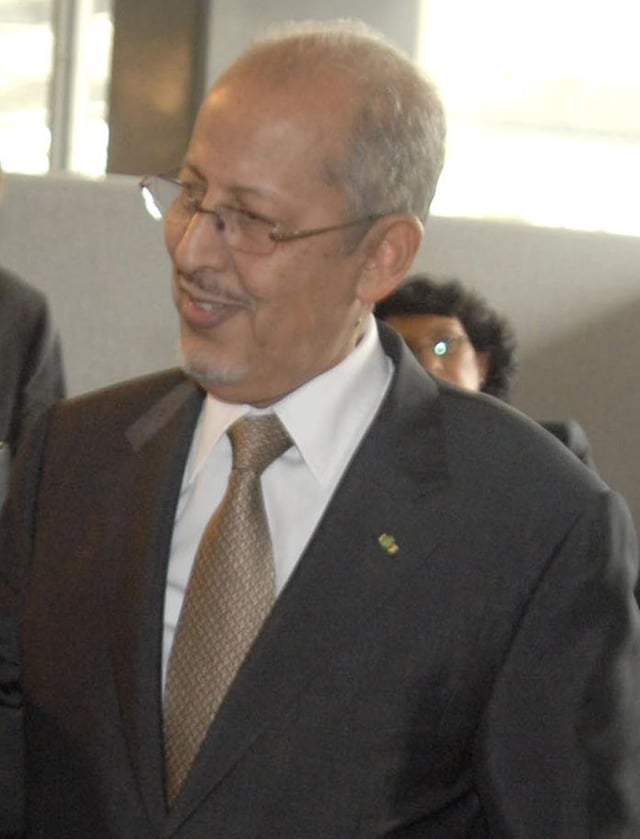
Sidi Ould Cheikh Abdallahi
Mauritania's first fully democratic presidential elections took place on 11 March 2007. The elections effected the final transfer from military to civilian rule following the military coup in 2005. This was the first time since Mauritania gained independence in 1960 that it elected a president in a multi-candidate election.[43]
The elections were won in a second round of voting by Sidi Ould Cheikh Abdallahi, with Ahmed Ould Daddah a close second.
2008 military coup
On 6 August 2008, the head of the presidential guards took over the president's palace in Nouakchott, a day after 48 lawmakers from the ruling party resigned in protest of President Abdallahi's policies. The army surrounded key government facilities, including the state television building, after the president fired senior officers, one of them the head of the presidential guards.[44] The President, Prime Minister Yahya Ould Ahmed Waghef, and Mohamed Ould R'zeizim, Minister of Internal Affairs, were arrested.
The coup was co-ordinated by General Mohamed Ould Abdel Aziz, former chief of staff of the Mauritanian Army and head of the presidential guard, who had recently been fired. Mauritania's presidential spokesman, Abdoulaye Mamadouba, said the President, Prime Minister, and Interior Minister had been arrested by renegade Senior Mauritanian army officers and were being held under house arrest at the presidential palace in the capital.[45][46][47] In the apparently successful and bloodless coup, Abdallahi's daughter, Amal Mint Cheikh Abdallahi, said: "The security agents of the BASEP (Presidential Security Battalion) came to our home and took away my father."[48] The coup plotters, all dismissed in a presidential decree shortly beforehand, included Abdel Aziz, General Muhammad Ould Al-Ghazwani, General Philippe Swikri, and Brigadier General (Aqid) Ahmad Ould Bakri.[49]
After the coup
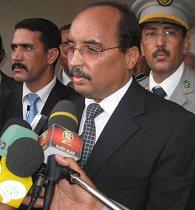
Mohamed Ould Abdel Aziz in his hometown, Akjoujt, on 15 March 2009

2011–12 Mauritanian protests
A Mauritanian lawmaker, Mohammed Al Mukhtar, claimed that many of the country's people supported the takeover of a government that had become "an authoritarian regime" under a president who had "marginalized the majority in parliament."[50] The coup was also backed by Abdallahi's rival in the 2007 election, Ahmed Ould Daddah. However, Abdel Aziz's regime was isolated internationally, and became subject to diplomatic sanctions and the cancellation of some aid projects. It found few supporters (among them Morocco, Libya and Iran), while Algeria, the United States, France and other European countries criticized the coup, and continued to refer to Abdallahi as the legitimate president of Mauritania. Domestically, a group of parties coalesced around Abdallahi to continue protesting the coup, which caused the junta to ban demonstrations and crack down on opposition activists. International and internal pressure eventually forced the release of Abdallahi, who was instead placed under house arrest in his home village. The new government broke off relations with Israel. In March 2010, Mauritania's female foreign minister Mint Hamdi Ould Mouknass announced that Mauritania had cut ties with Israel in a "complete and definitive way."[51]
After the coup, Abdel Aziz insisted on holding new presidential elections to replace Abdallahi, but was forced to reschedule them due to internal and international opposition. During the spring of 2009, the junta negotiated an understanding with some opposition figures and international parties. As a result, Abdallahi formally resigned under protest, as it became clear that some opposition forces had defected from him and most international players, notably including France and Algeria, now aligned with Abdel Aziz. The United States continued to criticize the coup, but did not actively oppose the elections.
Abdallahi's resignation allowed the election of Abdel Aziz as civilian president, on 18 July, by a 52% majority. Many of Abdallahi's former supporters criticized this as a political ploy and refused to recognize the results. They argued that the election had been falsified due to junta control, and complained that the international community had let down the opposition. Despite complaints, the elections were almost unanimously accepted by Western, Arab and African countries, which lifted sanctions and resumed relations with Mauritania. By late summer, Abdel Aziz appeared to have secured his position and to have gained widespread international and internal support. Some figures, such as Senate chairman Messaoud Ould Boulkheir, continued to refuse the new order and call for Abdel Aziz's resignation.
In February 2011, the waves of the Arab Spring spread to Mauritania, where thousands of people took to the streets of the capital.[52]
In November 2014, Mauritania was invited as a non-member guest nation to the G20 summit in Brisbane.
Society
Demographics
As of 2016, Mauritania had a population of approximately 4.3 million. The local population is divided into three main ethnic tiers: Bidhan or Moors, Haratin, and West Africans. The CIA World Factbook estimates 30% Bidhan, 40% Haratin, and 30% others. Local statistics bureau estimations indicates that the Bidhan represent around 53% of citizens. They speak Hassaniya Arabic and are primarily of Arab-Berber origin. The Haratin constitute roughly 34% of the population. They are descendants of former slaves and also speak Arabic. The remaining 13% of the population largely consists of various ethnic groups of West African descent. Among these are the Niger-Congo-speaking Halpulaar (Fulbe), Soninke, Bambara and Wolof.[2]
Religion
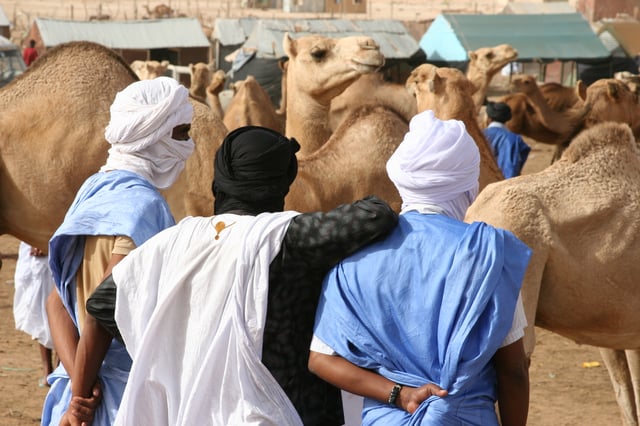
Camel market in Nouakchott
Mauritania is nearly 100% Muslim, with most inhabitants adhering to the Sunni denomination.[2] The Sufi orders, the Tijaniyah and the Qadiriyyah, have great influence not only in the country, but in Morocco, Algeria, Senegal and other neighborhood countries as well. The Roman Catholic Diocese of Nouakchott, founded in 1965, serves the 4,500 Catholics in Mauritania (mostly foreign residents from West Africa and Europe). There are extreme restrictions on freedom of religion and belief in Mauritania; it is one of thirteen countries in the world which punishes atheism by death.[53] On 27 April 2018, The National Assembly passed a law that makes the death penalty mandatory for anyone convicted of "blasphemous speech" and acts deemed "sacrilegious". The new law eliminates the possibility under article 306 of substituting prison terms for the death penalty for certain apostasy-related crimes if the offender promptly repents. The law also provides for a sentence of up to two years in prison and a fine of up to 600,000 Ouguiyas (approximately EUR 14,630) for "offending public indecency and Islamic values" and for "breaching Allah’s prohibitions" or assisting in their breach.[54]
Languages
Arabic is the official and national language of Mauritania. The local spoken variety, known as Hassaniya, contains many Berber words and significantly differs from the Modern Standard Arabic that is used for official communication. Pulaar, Soninke and Wolof also serve as national languages.[2] French is widely used in the media and among educated classes.[55]
Health
Life expectancy at birth was 61.14 years (2011 estimate).[2] Per capita expenditure on health was 43 US$ (PPP) in 2004.[56] Public expenditure was 2% of the GDP in 2004 and private 0.9% of the GDP in 2004.[56] In the early 21st century, there were 11 physicians per 100,000 people.[56] Infant mortality is 60.42 deaths/1,000 live births (2011 estimate).[56]
The obesity rate among Mauritanian women is high, perhaps in part due to the traditional standards of beauty (in some regions in the country), in which obese women are considered beautiful while thin women are considered sickly.[57]
Education
Mauritania has the University of Nouakchott and other institutions of higher education, but the majority of highly educated Mauritanians have studied outside the country. Public expenditure on education was at 10.1% of 2000–2007 government expenditure.[56]
Urbanization
Administrative divisions
The government bureaucracy is composed of traditional ministries, special agencies, and parastatal companies. The Ministry of Interior spearheads a system of regional governors and prefects modeled on the French system of local administration. Under this system, Mauritania is divided into 15 regions (wilaya or régions).
Control is tightly concentrated in the executive branch of the central government, but a series of national and municipal elections since 1992 have produced limited decentralization. These regions are subdivided into 44 departments (moughataa). The regions and capital district (in alphabetical order) and their capitals are:
| Region | Capital | |
|---|---|---|
| Adrar | Atar | 1 |
| Assaba | Kiffa | 2 |
| Brakna | Aleg | 3 |
| Dakhlet Nouadhibou | Nouadhibou | 4 |
| Gorgol | Kaédi | 5 |
| Guidimaka | Sélibaby | 6 |
| Hodh Ech Chargui | Néma | 7 |
| Hodh El Gharbi | Ayoun el Atrous | 8 |
| Inchiri | Akjoujt | 9 |
| Nouakchott-Nord | Dar-Naim | 10 |
| Nouakchott-Ouest | Tevragh-Zeina | 10 |
| Nouakchott-Sud | Arafat | 10 |
| Tagant | Tidjikdja | 11 |
| Tiris Zemmour | Zouérat | 12 |
| Trarza | Rosso | 13 |
Geography
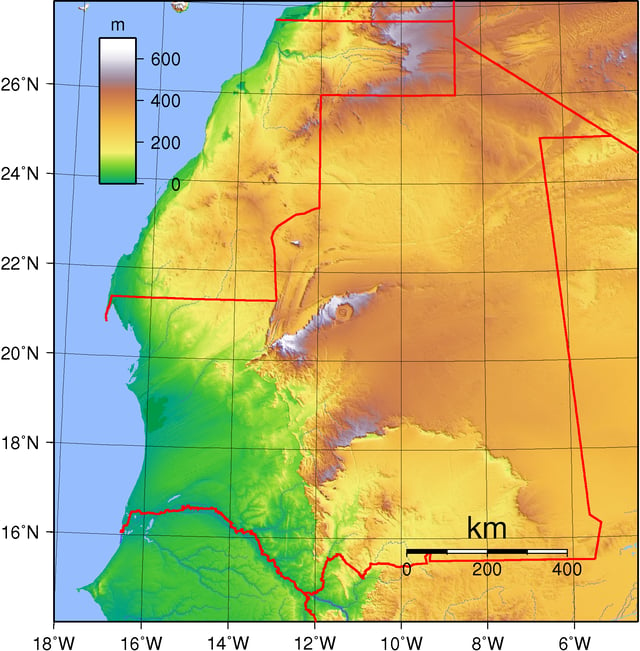
Topography of Mauritania
Mauritania is in the western region of the continent of Africa, is generally flat, its 1,030,700 square kilometres forming vast, arid plains broken by occasional ridges and clifflike outcroppings.[60] It borders the North Atlantic Ocean, between Senegal and Western Sahara, Mali and Algeria.[60] It is considered part of both the Sahel and the Maghreb. A series of scarps face southwest, longitudinally bisecting these plains in the center of the country. The scarps also separate a series of sandstone plateaus, the highest of which is the Adrar Plateau, reaching an elevation of 500 metres. [61]Spring-fed oases lie at the foot of some of the scarps. Isolated peaks, often rich in minerals, rise above the plateaus; the smaller peaks are called guelbs and the larger ones kedias. The concentric Guelb er Richat is a prominent feature of the north-central region. Kediet ej Jill, near the city of Zouîrât, has an elevation of 1,000 metres and is the highest peak.
Approximately three-quarters of Mauritania is desert or semidesert.[62] As a result of extended, severe drought, the desert has been expanding since the mid-1960s. The plateaus gradually descend toward the northeast to the barren El Djouf, or "Empty Quarter," a vast region of large sand dunes that merges into the Sahara Desert. To the west, between the ocean and the plateaus, are alternating areas of clayey plains (regs) and sand dunes (ergs), some of which shift from place to place, gradually moved by high winds. The dunes generally increase in size and mobility toward the north.
Belts of natural vegetation, corresponding to the rainfall pattern, extend from east to west and range from traces of tropical forest along the Sénégal River to brush and savanna in the southeast. Only sandy desert is found in the centre and north of the country.
Economy
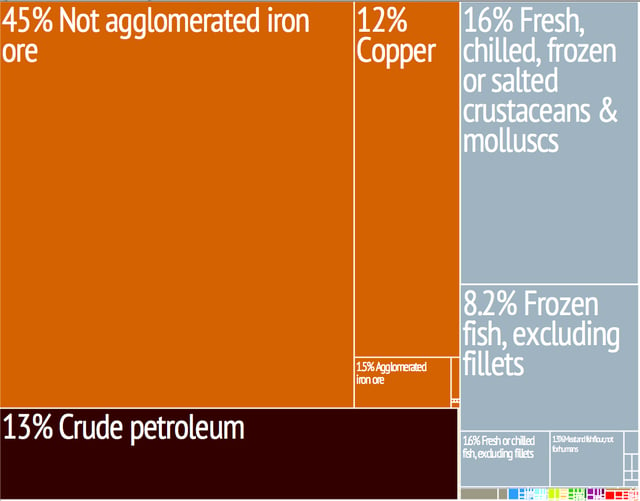
Graphical depiction of Mauritania's product exports in 28 color-coded categories
Despite being rich in natural resources, Mauritania has a low GDP.[63] A majority of the population still depends on agriculture and livestock for a livelihood, even though most of the nomads and many subsistence farmers were forced into the cities by recurrent droughts in the 1970s and 1980s.[63] Mauritania has extensive deposits of iron ore, which account for almost 50% of total exports. Gold and copper mining companies are opening mines in the interior.
The country's first deepwater port opened near Nouakchott in 1986. In recent years, drought and economic mismanagement have resulted in a buildup of foreign debt. In March 1999, the government signed an agreement with a joint World Bank-International Monetary Fund mission on a $54 million enhanced structural adjustment facility (ESAF). Privatization remains one of the key issues. Mauritania is unlikely to meet ESAF's annual GDP growth objectives of 4–5%.
Oil was discovered in Mauritania in 2001 in the offshore Chinguetti field. Although potentially significant for the Mauritanian economy, its overall influence is difficult to predict. Mauritania has been described as a "desperately poor desert nation, which straddles the Arab and African worlds and is Africa's newest, if small-scale, oil producer."[64] There may be additional oil reserves inland in the Taoudeni basin, although the harsh environment will make extraction expensive.[65]
United Arab Emirates government, via its pilot green city Masdar, announced it will install new solar plants in the city of Atar which will supply an additional 16.6 megawatts of electricity. The plants will power about 39,000 homes and save 27,850 tonnes of carbon emissions per year.[66]
Human rights
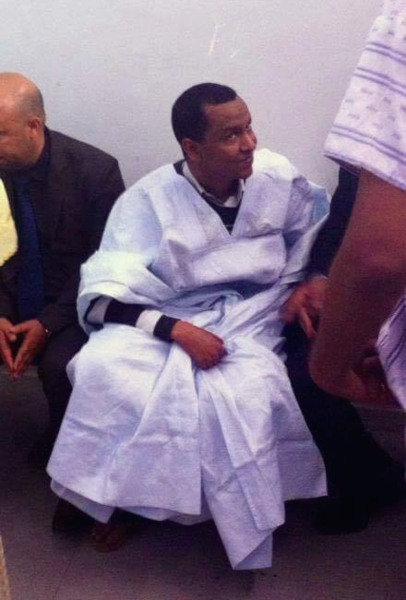
Mauritanian blogger and political prisoner Mohamed Cheikh Ould Mkhaitir
The Abdallahi government was widely perceived as corrupt and restricted access to government information. Sexism, racism, female genital mutilation, child labour, human trafficking, and the political marginalization of largely southern-based ethnic groups continued to be problems.[67] Homosexuality is illegal and is a capital offense in Mauritania.[68]
Following the 2008 coup, the military government of Mauritania faced severe international sanctions and internal unrest. Amnesty International accused it of practicing coordinated torture against criminal and political detainees.[69] Amnesty has accused the Mauritanian legal system, both before and after the 2008 coup, of functioning with complete disregard for legal procedure, fair trial, or humane imprisonment. The organization has said that the Mauritanian government has practiced institutionalized and continuous use of torture throughout its post-independence history, under all its leaders.[70][71][72]
According to the US State Department 2010 Human Rights Report,[73] abuses in Mauritania include:
...mistreatment of detainees and prisoners; security force impunity; lengthy pretrial detention; harsh prison conditions; arbitrary arrests; limits on freedom of the press and assembly; corruption; discrimination against women; female genital mutilation (FGM); child marriage; political marginalization of southern-based ethnic groups; racial and ethnic discrimination; slavery and slavery-related practices; and child labor.
Mauritanian blogger Mohamed Cheikh Ould Mkhaitir was sentenced to death after he wrote an article critical of religion and the caste system in Mauritania. He is a designated prisoner of conscience by Amnesty International.[74]
Modern slavery
The US State Department 2010 Human Rights Report states, "Government efforts were not sufficient to enforce the antislavery law. No cases have been successfully prosecuted under the antislavery law despite the fact that de facto slavery exists in Mauritania."[73]
Obstacles to ending slavery in Mauritania include:
Culture
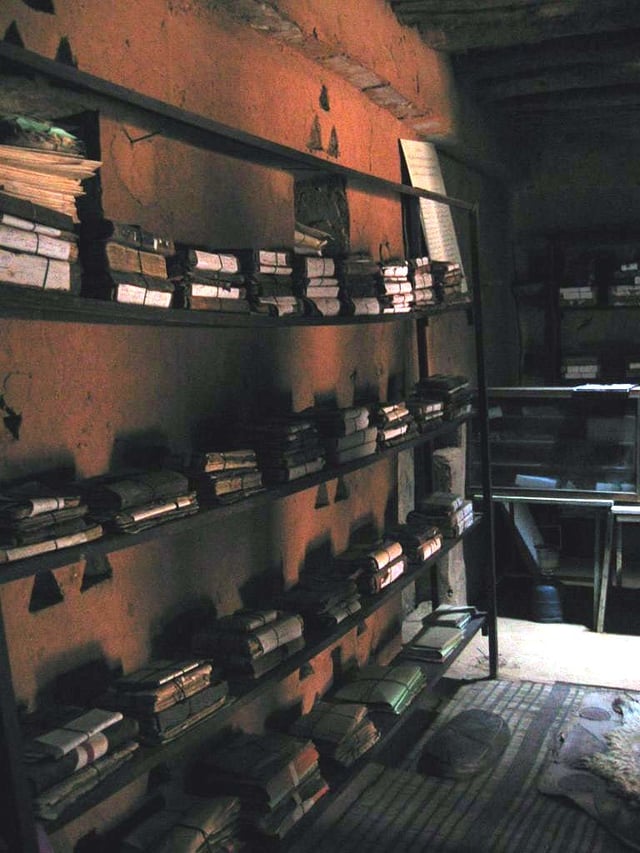
Qur'an collection in a library in Chinguetti
Filming for several documentaries and films has taken place in Mauritania, including Fort Saganne (1984), The Fifth Element (1997), Winged Migration (2001), and Timbuktu (2014).
See also
Index of Mauritania-related articles
Outline of Mauritania

